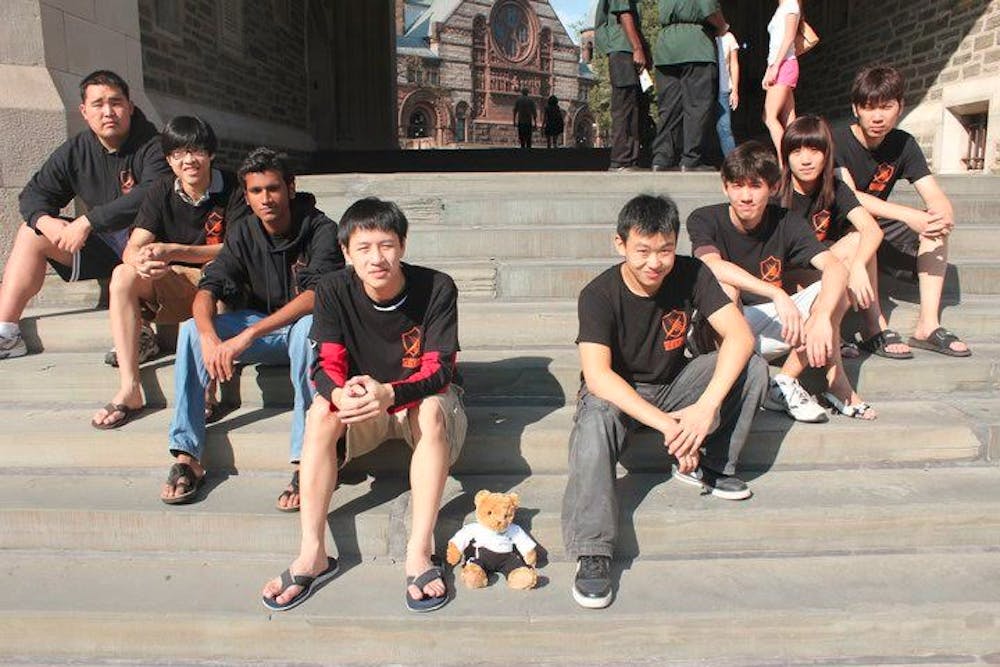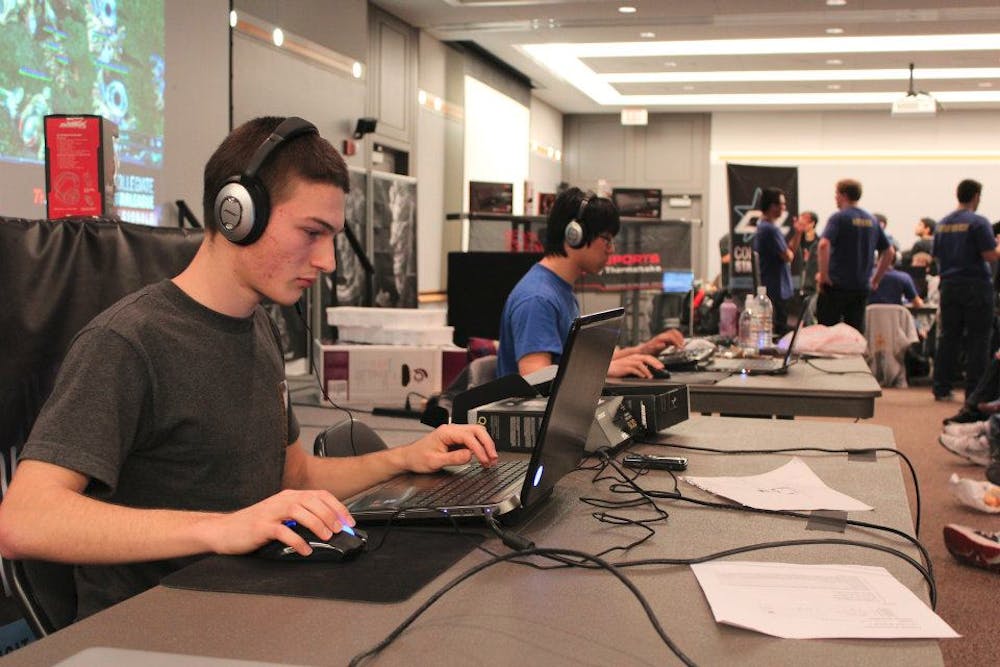Over six years ago, on March 9, 2012, teams from 23 colleges gathered in the Frist multipurpose room to kick off a weekend of competitive e-gaming. Playing for $1,500 and Collegiate Star League playoff eligibility, the teams undertook their challenge for the weekend — StarCraft.
The video game StarCraft is notorious for being technically demanding. Players take command of one of three unique races. Each race has its own playstyle and tactics, and players must build an army and overwhelm the opponent. To have any chance at winning, they must master both “micro,” the ability to control each unit individually, and “macro,” the ability to maintain economy, as well as execute an overarching strategy. Professional players often average close to 500 actions per minute over the course of a game.
The competition itself featured a group stage and a single-elimination best-of-five playoff. Each team brought in its own set of gaming laptops and connected to the local network to play in the tournament. The power even ran out at some point due to the sheer number of electronics being used.
Mona “hazelynut” Zhang ’12, founder of both the Princeton eSports Club and the CSL, said that at the time it was hard to believe that it’d all started just three years ago with a small group of Princeton gamers in 2009. She became involved in gaming in high school and wanted a gaming community when she was in college.
“I was like, I want there to be a Princeton team or at least a Princeton community,” she explained. “The moment I came onto campus, I was on the prowl to pry gamers out of their proverbial gamer closets.”
Initially, the group was composed only of StarCraft players. But they could not find enough to accumulate the 20 signatures required for becoming a University-recognized club. They decided to expand to include Super Smash Bros. and Guitar Hero players.
“So our first name was SmashCraft Heroes,” Zhang said.

Things moved quickly from there. SmashCraft Heroes had its first intramural StarCraft match on Nov. 21, 2008, and its first intercollegiate StarCraft match against MIT on Feb. 7, 2009.
In preparation for the MIT match, the team trained weekly in Frist 309, oftentimes practicing into the early morning. These sessions came complete with a coach, pizza, and homework. Unfortunately, the SmashCraft Heroes lost to MIT 2–3.

Two months later, the team faced off against Tsinghua University in China. The match between the two colleges, ranked no. 1 academically in their respective countries, even prompted a New York Times article. By fall of 2009, the CSL had been formally incorporated, and soon after, the league had 26 schools in the first season.
By Zhang’s senior year, the CSL had grown exponentially, featuring a nationwide league complete with regional local area networks and hefty prize pools.
“It was a nightmare to put together… I did really poorly on my thesis by my standards, but I threw an event that I will remember forever,” Zhang said.
Nearly 10 years later, eSports has grown tremendously. The CSL now spans 10 different games with over a thousand competing teams and a six-figure prize pool. The professional scene has grown even more. Dota 2’s “The International 2017” offered a prize pool of $24,787,916 and League of Legend’s “2017 World Championship” reached 60 million unique viewers. Neither game even existed when SmashCraft Heroes was formed.
“It definitely felt like a small beginning back then,” Zhang said. “The scene’s really growing.”
Because the gaming scene has been changing so rapidly, SmashCraft Heroes changed its name to the Princeton eSports Club, Zhang said.
Over the next few years under Kevin “uikos” Lin ’14 and An “StaRDuST” Chu ’17, the club also shifted from focusing on competitive StarCraft to accommodating a myriad of new video games.
In particular, the “multiplayer online battle arena” genre took off.
Beginning as a StarCraft custom game module, the MOBA DotA Allstars, followed by its counterpart League of Legends and its successor Dota 2, gained massive popularity. Instead of managing an entire army, players would control a single powerful hero in a five-on-five battle.
First-person shooter games, strategic card games, and countless other games have also emerged within the club. Each has its own appeal, so a range of players can find a game they enjoy.
“The diversity in terms of interest has never been as big as it is now,” Chu said. “The problem of being a part of a group where you don’t play the same game has always been an issue for the eSports Club.”
“Kevin’s philosophy, which I was basically running off of, was that Kevin valued having a club that was more about having a group of friends together,” Chu said.
In one sense, club meetings are an avenue to relax and have fun. For instance, Chu recalled that the club created a lot of memes even when memes didn’t become mainstream yet. But Chu also emphasized that club meetings are also meant to “develop meaningful relationships.”
Keo “NaCl” Chan ’18, captain of the DotA team, explained that “being on a team is not just about how you play; it’s also about communication and building a connection between players.”
The club’s role, then, was pretty clear. Chu noted that in 2013, the team was required to spend time together due to limited internet infrastructure and insufficient audio communication.
Recent technological innovations have largely resolved this necessity. The popularization of Twitch, a platform for viewing live-streamed gaming, ushered in an era of spectator gaming where streamers make a living off entertainment.
The introduction of Discord, a platform providing audio communication between gamers, allowed gamers to play from the comfort of their dorms. Gaming no longer required gathering people, laptops, and wires into a single room.
Nowadays, the eSports Club serves a facilitative role. Justin “JPirate” Tran ’20, the current president of the club, explained that “we develop a casual side and a competitive side.”
The club organizes competitive teams that primarily compete in the various CSL leagues. This semester, the League of Legends team maintained a perfect 14–0 record. In addition, Tran noted that both the Princeton League of Legends and DotA teams were invited this fall by the World Cyber Arena to an all-expenses paid collegiate tournament in Beijing, though they could not attend.
Frank “Deltice” Li ’19, a member of the Hearthstone team, explained that the preparation process for tournaments requires significant strategizing.
“We prepare by checking what decks past opponents have played and predicting what they would play against us, and then picking our decks as a best response,” he explained.
The club also runs gaming events, which encourage gamers to meet and play, and a Princeton eSports Facebook group that helps connect its 389 members.
“For me the main benefit of eSports is giving a sense of community — it provides an easy to reach entertainment and social scene rather than going to parties,” Himawan “Hima” Winarto ’18, a member of the DotA team, said.
When asked about the future of eSports, Zhang wondered when the community would “reach a stability point where we can really just start committing to these games,” since the current fast-evolving nature of gaming leads it to be “more about breadth and less about depth.”
“My hope is that through all this experimentation and creation of amazing games, eventually the one true game, two true games of their genres crystallize and consolidate, and people can return to them to make it their life sport,” Zhang said.
Chu noted that this raises the question of whether the club should receive more administrative support, especially in light of the rising popularity of eSports. Chu stressed that eSports should be treated separately from conventional sports and shouldn’t be fit into “an existing space of competition.”
“eSports needs to be promoted to a level of support that transcends an ODUS club,” said Chu. “Perhaps if there is interest in doing that, you know, and if Princeton decides, whether it’s the administration or students or maybe the society at large, which wants to see more collegiate competition.”
As technology inevitably advances, gaming and eSports will continue to evolve, with the possibility of incorporating recent progress in artificial intelligence and virtual reality.
The tournaments for this school year are all finished, but the club is already planning an Ivy League eSports conference event for the fall.








